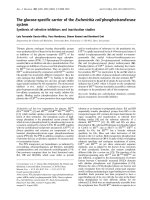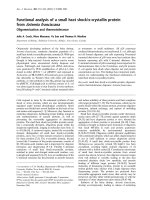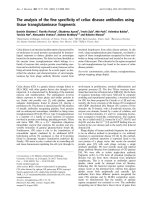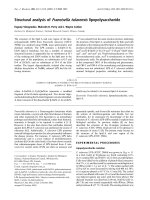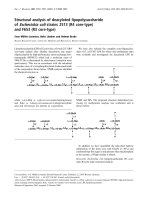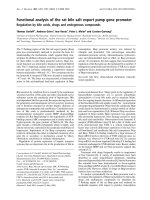Báo cáo Y học: The analysis of the fine specificity of celiac disease antibodies using tissue transglutaminase fragments pot
Bạn đang xem bản rút gọn của tài liệu. Xem và tải ngay bản đầy đủ của tài liệu tại đây (210.23 KB, 7 trang )
The analysis of the fine specificity of celiac disease antibodies using
tissue transglutaminase fragments
Daniele Sblattero
1
, Fiorella Florian
1
, Elisabetta Azzoni
1
, Trevin Zyla
3
, Min Park
3
, Valentina Baldas
2
,
Tarcisio Not
2
, Alessandro Ventura
2
, Andrew Bradbury
3,4
and Roberto Marzari
1
1
Dipartimento di Biologia, University of Trieste, Trieste, Italy;
2
IRCSS, Burlo Garofolo, Trieste, Italy;
3
Biosciences Division;
Los Alamos National Laboratory, Los Alamos, New Mexico, USA;
4
SISSA, Trieste, Italy
Celiac disease is an intestinal malabsorption characterized by
an intolerance to cereal proteins accompanied by immuno-
logical responses to dietary gliadins and an autoantigen
located in the endomysium. The latter has been identified as
the enzyme tissue transglutaminase which belongs to a
family of enzymes that catalyze protein cross-linking reac-
tions and is constitutively expressed in many tissues as well as
being activated during apoptosis. In a recent paper, we des-
cribed the selection and characterization of anti-transglu-
taminase Igs from phage antibody libraries created from
intestinal lymphocytes from celiac disease patients. In this
work, using transglutaminase gene fragments, we identify a
region of tissue transglutaminase recognized by these anti-
bodies as being conformational and located in the core do-
main of the enzyme. This is identical to the region recognized
by anti-transglutaminase Igs found in the serum of celiac
disease patients.
Keywords: autoimmunity; celiac disease; transglutaminase;
epitope mapping; phage display.
Celiac disease (CD) is a genetic disease strongly linked to
HLA DQ2, with other genetic factors also thought to be
important. It is characterized by flattening of the intestinal
mucosa and malabsorption. The pathogenesis involves
dietary exposure to wheat gluten and similar proteins in
rye, barley and possibly oats [1], with gliadins, specific
antigenic determinants found in glutens [2], playing a
prominent role. The disease is characterized by the presence
of specific antibodies recognizing gliadins, food proteins
and an endomysial autoantigen, identified as being tissue
transglutaminase (tTG) [3]. tTG or type 2 transglutaminase
is a member of a family of seven isoforms of enzymes
involved in protein cross-linking, including prostatic TGase
and factor XIII. tTG is a Ca
2+
-dependent ubiquitous
intracellular enzyme that catalyzes the covalent and irre-
versible formation of gamma glutamyl-lysine bonds [4].
Furthermore, tTG plays a role in the transduction of
extracellular signals, mediated by its additional GTP-
hydrolyzing activity [5], analogous to that of G-proteins
found in adrenergic receptor transduction pathways [6].
Finally, tTG seems to play a critical role in controlling cell
and tissue homeostasis regulating the cell cycle through its
involvement in proliferation, terminal differentiation and
apoptotic processes [7]. The first TGase structure deter-
mined has been that of human factor XIIIA [8]. On the basis
of sequence homology with factor XIII and by computer
modeling and experimental approaches, a structural model
for tTG has been proposed by Casadio et al.[9]andvery
recently, the X-ray structure of the human tTG complexed
with GDP, determined [10]. Human tTG consists of four
domains: the N domain, with a b-sandwich structure, the
enzyme core domain, formed by a series of a-helices, and
two C-terminal domains, C1 and C2, containing b-struc-
tures arranged in barrel-like conformations. The catalytic
site, the so called triad [11], formed by Cys277, His335 and
Asp358, and also the Ca
2+
[12] and GTP binding sites are
located in the core domain and in the nearby first b-barrel
domain [10].
Phage display of human antibody fragments has proved
to be an effective method to investigate in vivo antibody
responses in autoimmune disease [13,14]. In this method,
a patient’s antibody repertoire is expressed fused to the
coat protein of a phage vector that carries the encoded
protein gene [15], with each phage carrying a single
antibody specificity. We have recently made and selected
phage antibody libraries from lymphocytes of CD patients
[16]. We were able to isolate single-chain antibody
fragments (scFv) to tTG from all intestinal lymphocyte
libraries but not from those obtained from peripheral
lymphocytes. This is in contrast to antibodies against
gliadin, which could be obtained from all libraries,
indicating that the humoral response against transgluta-
minase occurs at the intestinal level, whereas that against
gliadin occurs both peripherally and centrally. IgA
antibodies from three different patients recognized the
same tTG epitopes and by ELISA competition experi-
ments we demonstrated that the number of epitopic
regions recognized was restricted to two. The antibodies
recognizing one of these had a bias in favor of genes from
Correspondence to D. Sblattero, Department of Biology,
University of Trieste, via L Giorgieri, 10, 34127 Trieste, Italy.
Fax: + 39 40 568855, Tel.: +39 40 558 3895,
E-mail:
Abbreviations: BCIP, 5-bromo-4-chloroindol-3-yl phosphate;
CD, celiac disease; Ep, epitope; GP, guinea-pig; IPTG, isopropyl
thio-b-
D
-galactoside; scFv, single-chain antibody fragment;
TMB, 3,3¢,5,5¢-tetramethylbenzidine dihydrochloride; tTG, tissue
transglutaminase.
Enzymes: transglutaminase (EC 2.3.2.13).
(Received 6 June 2002, revised 2 August 2002,
accepted 29 August 2002)
Eur. J. Biochem. 269, 5175–5181 (2002) Ó FEBS 2002 doi:10.1046/j.1432-1033.2002.03215.x
the VH5 antibody family and were also able to recognize
guinea-pig (GP) tTG, which the other was not.
In this study, we report the cloning and expression of tTG
gene fragments in order to map the antigenic regions
recognized by these monoclonal phage antibodies as well as
sera from CD patients.
MATERIALS AND METHODS
Bacterial strains
DH5aF¢ {F¢/endA1 hsdR17 (r
K–
m
K+
) supE44 thi-1 recA1
gyrA (Nal
r
) relA1 D (lacZYA-argF)U169 deoR [F
80
dLac-
D(lacZ)M15]} was used for cloning, and HB2151 [K12, ara
D(lac-pro),thi/F¢ proA
+
B
+
,lacIqZDM15] was used to
make soluble scFv. Plasmid pTrcHisB (Invitrogen) was
used to express tTG domains. Molecular biology enzymes
were purchased from New England Biolabs, Promega or
Life Technologies.
Antigens
GP tTG was purchased from Sigma. Human tTG cDNA
was obtained by amplifying cDNA from an intestinal
biopsy with specific primers [17] and cloning into pTrcHisB.
PCR amplification and cloning of tTG deletion mutants
tTG fragments were obtained by PCR amplification from
the cloned tTG gene. The primers used to amplify 12 tTG
sequences are described in (Table 1). Upon amplification
(30 cycles of 94 °C1min,60°C1min,72°C, 2 min), all
tTG fragments contained a 5¢ Bgl II restriction site and a 3¢-
EcoR I site used for cloning. The primary PCR amplifica-
tion products were digested with Bgl II and EcoR I and gel
purified to subclone into the pTrcHisB vector. After
transformation of Escherichia coli DH5aF¢ cells, positive
clones were identified by PCR using the same primers used
for PCR amplification.
tTG fragments expression and purification
Bacteria were grown in 2xYT amp medium at 37 °Cto
D
600
0.5, induced with 0.2 m
M
, isopropyl thio-b-
D
-galacto-
side (IPTG) and incubated at 28 °C for an additional 5 h.
The soluble cytoplasmic fraction was prepared by extraction
of pelleted bacteria with lysozyme 1 mgÆg
)1
bacteria in lysis
buffer (20 m
M
Tris pH 8.0, 500 m
M
NaCl, 5 m
M
imidazole,
0.1% Triton X 100, 20 lgÆmL
)1
DNase) followed by centri-
fugation for 15 min at 27 000 g. The supernatant was col-
lected and dialyzed against NaCl/P
i
(Na
2
HPO
4
/NaH
2
PO
4
10 m
M
pH 7.4, NaCl 0.15
M
). Purified fragments were
obtained by affinity chromatography of the bacterial extract
on Ni/nitrilotriacetic acid resin (Qiagen) which selectively
binds the six histidines at the N-terminus of the fragments.
Human sera and scFvs
Human sera were obtained from 24 untreated celiac disease
patients positive for anti-tTG and anti-endomysial Igs with
positive histological analysis of the intestinal mucosa. A
further 12 sera with antibodies to tTG were obtained
from nonceliac patients affected by other pathologies and 20
from healthy donors. ScFvs to tTG from phage display
libraries were obtained from bacterial culture supernatants.
Briefly, phagemids from individual colonies were infected
into E. coli HB2151, grown to D
600
¼ 0.5, induced with
0.5 m
M
, IPTG and further grown overnight at 28 °C. ScFvs
were used directly as supernatants of induced bacterial
cultures.
ELISA
ELISA was performed by coating ELISA plates with
purified tTG and tTG fragments at 10 lgÆmL
)1
for 15 h at
4 °C. Wells were blocked with 2% nonfat milk in NaCl/P
i
(MPBS) and washed three times with NaCl/P
i
plus 0.1%
Tween20 and three times with NaCl/P
i
. Primary antibodies
used were CUB7402, a commercial anti-tTG Ig (Neo-
marker), His-probe H3, an anti-histidine tag Ig (Santa
Cruz), soluble cloned scFvs to tTG as previously described
[16] and human sera. The antibodies were used as following:
(a) CUB7402, diluted 1 : 1000 with MPBS and His-probe
diluted 1 : 1000 followed by goat anti-(mouse IgG)
conjugated with HRP (Dako) (b) scFvs, diluted 1 : 1,
mAb recognizing the SV5 tag [18] found at the scFv C
terminus followed by goat anti-(mouse IgG) conjugated
with HRP (Dako); (c) human sera, diluted 1 : 200 followed
by goat anti-(human IgA) conjugated with HRP
(Sigma). All the immunocomplexes were revealed with
Table 1. Primers used to amplify 12 tTG deletion mutants. Enzyme restriction sites for BglII and EcoRI are in italics. The bold sequences correspond
to the tTG gene.
Primer name Primer sequence Amino acids
N back AGCTCG
AGATCT
ATGGCCGAGGAGCTGGTCTT 1–7
Core back AGCTCG
AGATCT
AACGCCTGGTGCCCAGCGGA 140–147
Core for TGAAGC
GAATTC
TTACTCCCTCTCCTCTGAGGACC 454–448
Loop for TGAAGC
GAATTC
TTAACGGATCCGCATGGCCATCC 479–473
C1 for TGAAGC
GAATTC
TTACTCCAGGTAGAGGTCCCTCT 585–579
C2 for TGAAGC
GAATTC
TTAGGCGGGGCCAATGATGAC 687–682
Loop back AGCTCG
AGATCT
GGGTCCTCAGAGGAGAGGAG 448–453
Core
269
back AGCTCG
AGATCT
TGCCAGCGCGTCAGGTATGGC 269–275
Core
376
back AGCTCG
AGATCT
GTTCGTGCCATCAGGGAGGGC 376–382
Core
269
for GAAGC
GAATTC
TTAGCCGTGGTTCTTCCAGCG 269–264
Core
376
for GAAGC
GAATTC
TTATGGAACTGGGCCACAGCA 376–371
5176 D. Sblattero et al. (Eur. J. Biochem. 269) Ó FEBS 2002
3,3¢,5,5¢-tetramethylbenzidine dihydrochloride (TMB) and
H
2
O
2
as substrates and read at A
450
.
Western blotting
SDS/PAGE was performed according to standard tech-
niques. Purified tTG fractions were separated by SDS/
PAGE and transferred onto nitrocellulose (Amersham) by
semi-dry blotting using the Pharmacia Multiphor II. The
membrane was blocked using MPBS for 1 h at room
temperature. CUB7402 and His-probe were used as primary
antibodies. After 2 h incubation at room temperature and
extensive washing with NaCl/P
i
plus 0.1% Tween 20, the
nitrocellulose was subsequently incubated with goat anti-
(mouse IgG) conjugated with alkaline phosphatase and
revealed by the chromogenic substrate BCIP (5-bromo-4-
chloroindol-3-yl phosphate) and Nitro Blue tetrazolium.
RESULTS
Cloning strategy
In a previous paper [16] we described the cloning of human
tTG in the pTrcHisB expression vector. Although this
cloning was effective, most of the tTG synthesized in
bacteria was present as insoluble inclusion bodies and only a
reduced amount of functional enzyme could be extracted
and purified. The inclusion body fraction can be solubilized
by 4
M
urea but neither the enzymatic activity nor the
antigenic functionality is recovered by renaturing proce-
dures. Also the soluble fraction, treated with 4
M
urea is no
longer recognized by CD sera and CD phage display
antibodies to tTG (unpublished results), strongly suggesting
that the epitopes recognized by these antibodies are very
sensitive to denaturation. These findings led us to investigate
the epitope specificity of these antibodies with a rational
approach in which PCR primers recognizing DNA
sequences encoding amino acidic sequences at the ends of
each of the putative four main tTG domains, as outlined by
[9] and substantially confirmed by [10], were used to amplify
these domains. The scheme of the tTG domains cloned
is reported in Fig. 1. We cloned seven tTG regions
combining different domains, here reported as tTG/1 to
tTG/7, as well as sequences comprising different lengths of
the core domain either at the 5¢-or3¢-terminus (tTG/8 to
tTG/12).
Cloning and expression of tTG regions
The fragments representing different combinations of tTG
domains were amplified by PCR using the primers described
in Table 1 and cloned into pTrcHisB using BglII and
EcoRI. Individual clones were screened by PCR using the
cloning primers and restriction digestion of plasmid DNA.
Clones were grown in liquid medium to D
600
¼ 0.5, induced
with IPTG for 5 h and fragments purified by Ni/nitrilotri-
acetic acid chromatography. The eluted fractions were
checked by SDS/PAGE and Western blotting. For this
purpose, two commercial mAbs were used as primary
antibodies: His-probe, a mAb directed to the six histidines
inserted at the N-terminus of the tTG fragments and
CUB7402, which recognizes a linear tTG epitope (amino
acids 447–478) located at a sequence overlapping the
C-terminal end of the core and the nearby loop. The
results of the Western blotting are depicted in Fig. 2. Using
His-probe, all the expressed tTG fragments showed elec-
trophoretic bands corresponding to the predicted molecular
weight (Fig. 2A). When the mAb CUB7402 was used
(Fig. 2B), all fractions had the same pattern, with the
exception of tTG/1, /4, /11 and /12 which lack the epitope
recognized by this antibody. Although all the fragments
showed bands with seemingly little or no proteolytic
degradation, differences in the intensity of the bands were
noted, probably reflecting different expression and/or
purification efficiencies. In Coomassie blue-stained
SDS/PAGE gels, all fractions showed a purity greater than
90% (not shown).
tTG fragments recognition by cloned antibodies
Full-length tTG and derived fragments were tested for their
ability to be recognized by the previously selected human
anti-tTG Igs [16]. Prior to that, the purified tTG fragments
were quantified, diluted to 10 lgÆmL
)1
, absorbed to the
wells of a microtiter plate and tested by mAbs CUB7042
and His-probe, previously used for Western blotting. The
results (not reported) showed that full-length tTG and all
the fragments were recognized to a similar extent, with the
exception of those not containing the linear epitope
recognized by CUB7042. This result attested that the
reactivity of the tTG fragments was similar and suitable for
testing differences in the reactivity of anti-tTG Igs. The
cloned human antibodies to tTG, expressed as scFv, were
previously selected from phage antibody libraries obtained
from intestinal biopsy lymphocytes from three untreated
Fig. 1. Schematic drawing of the cloning of 12 different tTG regions.
Reference numbers of the amino acid residues at the ends of the cloned
sequences are shown.
Ó FEBS 2002 Epitope mapping of anti-tTG Igs (Eur. J. Biochem. 269) 5177
CD patients and shown to recognize two distinct epitopes,
epitope 1 (Ep1) and epitope 2 (Ep2). Ep1 antibodies
predominantly belong to the VH5/DP73 gene family/
segment and also recognize GP tTG whereas Ep2 antibodies
do not belong to any consistent V gene family and do not
recognize GP tTG. Ten antibodies to tTG isolated from the
three libraries were challenged against the tTG fragments by
ELISA. All antibodies were previously titrated by ELISA
on full-length tTG. The working dilution was calculated as
the highest antibody dilution with an A value not lower than
90% of the saturating concentration. Remarkably, all the
antibodies showed equivalent results confirming that a
similar immune response arises in different CD patients. In
fact, the 10 antibodies tested were cloned from three CD
patients and this might be interpreted as a distinctive trait of
CD. The responses of four antibodies belonging to Ep1/
GP+ and Ep2/GP– clusters are reported in Fig. 3 as
examples. To avoid interference due to the different
affinities of the antibodies for the antigen, the A values
corresponding to interaction with full-length tTG have been
set to 100 and the A values for the individual tTG fragments
have been normalized as a corresponding percentage. From
Fig. 3 it is clear that the antibodies recognize the fragments
tTG/1, /2, /3, /7 and /11 but not tTG/4, /5, /6, /8, /9, /10 and
/12. A difference in the level of recognition was registered
for fragments tTG/2 and tTG/3, where the reactivity is, on
an average, far lower for the Ep2/GP– than the EP1/GP+
antibodies, reaching a reduction of around 75% for tTG/2.
All antibodies were tested on unrelated proteins such as
BSA, gliadin and lysozyme giving A values not exceeding
0.08.
Experiments in which the tTG was indirectly coupled to
the ELISA plates using purified rabbit anti-tTG serum
Igs gave similar results, indicating that significant denatur-
ation upon binding to the plastic is not occurring (not
shown).
tTG fragments recognition by CD sera
The tTG fragments were also tested with 24 sera from
untreated CD patients. The results, reported as reactivity of
the 24 sera against a given fragment are shown in Fig. 4A.
Also in this case reactivity to full-length tTG, with ELISA A
values comprised between 0.2 and 2, is set to 100% for
simplicity. The overall recognition pattern of IgA antibodies
show a trend very close to that of the cloned antibodies, with
Fig. 3. ELISA of tTG, 12 tTG fragments and GP tTG. Full-length tTG are set to 100 and the A values for the individual tTG fragments normalized
as a corresponding percentage. The upper table reports the absolute A values. The values correspond to the mean value of experiments in
triplicate. Primary antibodies: four cloned scFvs to tTG. Secondary antibodies: mAb SV5 and goat anti-mouse Ig conjugated with peroxidase.
Substrates: H
2
O
2
and TMB.
Fig. 2. Western blots of 12 purified tTG fragments. (A) Primary antibody, mAb His-probe. (B) Primary antibody, mAb CUB 7042. Secondary
antibody, goat anti-(mouse Ig) conjugated with alkaline phosphatase. Substrates were BCIP and Nitro Blue tetrazolium. Top right, full-length tTG
reported for reference.
5178 D. Sblattero et al. (Eur. J. Biochem. 269) Ó FEBS 2002
tTG fragments tTG/1, /2, /3, /7 and /11 being clearly
recognized. To further confirm the specificity of recognition
of tTG fragments by CD serum antibodies, 12 sera from
nonceliac patients with anti-tTG responses, were analyzed.
These showed a scattered response against all fragments,
unlike the CD patients. Here two fragments negative for
CD patients (tTG/4 and 8) and two positive (tTG/7 and 11)
are reported as examples. All these false positive sera were
previously demonstrated to have low titer (A ranging from
0.2 to 0.6) anti-tTG Igs whereas the donors did not show
any other CD marker such as CD associated HLA alleles or
jejunal biopsy with mucosal lesion although with CD
related symptoms such as recurrent abdominal pain and
failure to thrive. The results are reported in Fig. 4B. In this
case all the fragments, including tTG/4 and tTG/8, were
recognized from most of the sera although to a different
extent. The results of the two experiments were roughly the
same for both IgA and IgG. No reactivity (A <0.2)was
registered on all tTG fragments using control sera from 20
healthy donors.
DISCUSSION
The cloning of tTG fragments on the basis of the modeled
three-dimensional structure [8–10] coupled with the map-
ping of the residues involved in the functionality of the
molecule [5,10,19] allowed us to express and purify stable
tTG domain polypeptides. The low degree of protein
degradation, as attested by Western blotting, probably
reflects the fact that individual domains, which are likely to
be resistant to bacterial proteases, were expressed. Although
not examined formally, these fragments were found to be
stable, as little or no degradation, as well as no change in
ELISA A values, were registered after months of storage at
)20 °C.
By using mAbs recognizing the His tag and a linear
epitope within tTG as positive controls for expression, we
were able to normalize the coating of these fragments to
ELISA wells for a better interpretation of the reactivity of
cloned antibodies and patients’ sera. The overall response
of the cloned antibodies indicates that the recognized
region is located in the core of tTG spanning a sequence
not exceeding 237 amino acids (amino acids 140–376), as
proved by the reactivity of tTG/11, tTG/7, which overlap
by this region only. However, this conclusion is slightly
complicated by the lack of recognition of this core element
by tTG/4,/5,/6, which nevertheless contain it. This suggests
the epitope is a conformational one which requires full-
length N or C terminal domains for either stability or
correct folding, as shown by recognition of tTG/1, /2 and
/3. The possibility that unfolding of the tTG on the plastic
was responsible for these slightly discordant results was
explored by doing an indirect ELISA with the tTG fixed
using plates coated with purified rabbit anti-tTG poly-
clonal Igs rather than by adsorption to the plastic. The
results were identical to those presented. With respect to
the two putative epitopes Ep1/GP+ and Ep2/GP–,
appropriate antibodies show the same qualitative pattern
of reactivity, with some quantitative differences. The Ep2/
GP– antibodies (in the example in Fig. 3, reported as 2.15
and 4.2) seem to be influenced by possible steric hindrance
caused by the loop segment as proved by the difference in
the level of recognition of tTG/1 and tTG/2. Because the
loop has been shown to undergo structural changes when
the tTG molecule is activated by calcium ions [9], we tested
the reactivity of the tTG/1 and /2 fragments in the presence
of either Ca
2+
or EDTA, but observed no effect.
Comparison of human and GP tTG shows a limited
number of differences in the amino acidic sequence, but
these are scattered along the mapped antigenic region
preventing reliable identification of the site recognized by
Ep2 antibodies. No further information could be obtained
from the analysis of the recognition of cloned rat and
mouse tTG (data not shown), which gave a similar
recognition pattern to GP tTG. Interestingly, all the serum
antibodies from CD patients, tested individually showed
the same reactivity pattern, attesting the presence of
antibodies recognizing both Ep1 and Ep2, whereas no
reactivity to all the tTG fragment was registered using sera
from healthy donors. It has been proposed that phage
antibody libraries may be used as surrogates for the
humoral immune response of an autoimmune patient. In
our case, agreement was almost perfect, confirming that
the humoral autoimmune response in CD involves two
main immunodominant epitopes, with no exceptions noted
among the limited number of sera tested. A further control
Fig. 4. ELISA of tTG and tTG fragments. Full-length tTG are set to 100 and the A values for the individual tTG fragments normalized as a
corresponding percentage. (A) Primary antibody, 24 sera from untreated CD patients. (B) Primary antibody, 12 sera from non-CD patients affected
by other pathologies and with a serum antibody response to tTG. Secondary antibodies, goat anti-(human IgA) conjugated with peroxidase. The
dash represents the average of the values.
Ó FEBS 2002 Epitope mapping of anti-tTG Igs (Eur. J. Biochem. 269) 5179
is given by the use of sera to tTG from nonceliac donors.
All these patients were affected by non CD pathologies but
with a detectable serum titer to tTG. In this case, all tTG
fragments were recognized, including those not recognized
by CD sera. This finding suggests that the epitope/s
identified by the antibody clones are a distinctive marker of
CD and raises the question whether they may play a role
in the onset of the illness. In a recent work, Seissler et al.
[20] analyzed the recognition pattern of CD sera by using
tTG deletion mutants similar to those described in this
work. The authors find similar results to ours, with the
exception of their response to the C terminus, which was
absent in our analyses. This is likely to be due to the
differences in the methods used (immunoprecipitation of
radioactive tTG instead of ELISA on plastic bound
fragments), as well as the different fragments which are
not identical. We cannot exclude the possibility that a CD
serum response is directed to other epitopes, especially
against the C terminal part of tTG, which may be hidden
in the fragments we used.
Conformational epitopes are not exclusive to CD. In
autoimmune diabetes, the major autoantigen GA65 has
recently been found to expose nonlinear autoantigenic
sequences [21]. In our case, the minimal reactive antigenic
region we managed to identify, spans 237 amino acids in
the core domain, although it appears to require flanking
sequences for stability. This domain is formed mainly by
a-helices and harbors part of the putative calcium and
GTP binding regions [10,12] and the catalytic triad
formed by Cys277, His335 and Asp358 [11]. Interestingly,
all three of these amino acids are comprised in the
antigenic region we have identified. During the course of
inhibition experiments [22], we have demonstrated that the
cloned antibodies to tTG inhibit the in vitro enzymatic
activity of tTG. We interpret this result as indicating
either a direct interaction with the triad amino acids or a
consequence of steric hindrance causing an interference in
enzymatic activity.
In conclusion, by analyzing individual phage antibodies
isolated from patient libraries on the tTG fragments, we
have been able to restrict the antigenic region recognized to
the enzymatic core of tTG which is selectively recognized
by all the cloned antibodies as well as CD serum
antibodies. The role of the humoral response to tTG has
not been clarified yet, and the possibility of in vivo
inhibition of the enzymatic activity of tTG by CD
autoantibodies should be carefully considered. CD is
frequently accompanied by other autoimmune pathologies
whose onset might be strictly related to CD, as in patients
on gluten-free diet the risk of other autoimmune disorders
drops dramatically [23]. Transgenic mice lacking tTG have
been shown to exhibit altered thymocyte populations
[24,25]. The question arises whether antibodies to tTG
occurring in CD may cause autoimmune cell clones to
escape negative selection and apoptosis as recently pro-
posed [26]. Our procedure offers a novel approach for
the characterization of conformational epitopes possibly
involved in these mechanisms.
ACKNOWLEDGMENTS
This study was supported by grants n.E.1141 from Telethon and
number 2001063713/002 from MIUR.
REFERENCES
1. Goggins, M. & Kelleher, D. (1994) Celiac disease and other
nutrient related injuries to the gastrointestinal tract. Am. J. Gas-
troenterol. 89, S2–S17.
2. Wieser, H. (1996) Relation between gliadin structure and coeliac
toxicity. Acta Paediatr. Suppl. 412, 3–9.
3. Dieterich, W., Ehnis, T., Bauer, M., Donner, P., Volta, U.,
Riecken, E.O. & Schuppan, D. (1997) Identification of tissue
transglutaminase as the autoantigen of celiac disease. Nat. Med. 3,
797–801.
4. Greenberg, C.S., Birckbichler, P.J. & Rice, R.H. (1991) Trans-
glutaminases: multifunctional cross-linking enzymes that stabilize
tissues. FASEB J. 5, 3071–3077.
5. Iismaa,S.E.,Wu,M.J.,Nanda,N.,Church,W.B.&Graham,
R.M. (2000) GTP binding and signaling by Gh/transglutaminase
II involves distinct residues in a unique GTP-binding pocket.
J. Biol. Chem. 275, 18259–18265.
6. Nakaoka, H., Perez, D.M., Baek, K.J., Das, T., Husain, A.,
Misono,K.,Im,M.J.&Graham,R.M.(1994)Gh:aGTP-binding
protein with transglutaminase activity and receptor signaling
function. Science 264, 1593–1596.
7. Melino, G., Annicchiarico-Petruzzelli, M., Piredda, L., Candi, E.,
Gentile, V., Davies, P.J. & Piacentini, M. (1994) Tissue trans-
glutaminase and apoptosis: sense and antisense transfection
studies with human neuroblastoma cells. Mol. Cell. Biol. 14, 6584–
6596.
8. Yee, V.C., Pedersen, L.C., Le Trong, I., Bishop, P.D., Stenkamp,
R.E. & Teller, D.C. (1994) Three-dimensional structure of a
transglutaminase: human blood coagulation factor XIII. Proc.
Natl Acad. Sci. USA 91, 7296–7300.
9. Casadio, R., Polverini, E., Mariani, P., Spinozzi, F., Carsughi, F.,
Fontana, A., Polverino de Laureto, P., Matteucci, G. & Berga-
mini, C.M. (1999) The structural basis for the regulation of tissue
transglutaminase by calcium ions. Eur. J. Biochem. 262, 672–679.
10. Liu, S., Cerione, R.A. & Clardy, J. (2002) Structural basis for the
guanine nucleotide-binding activity of tissue transglutaminase and
its regulation of transamidation activity. Proc. Natl Acad. Sci.
USA 99, 2743–2747.
11. Pedersen, L.C., Yee, V.C., Bishop, P.D., Le Trong, I., Teller, D.C.
& Stenkamp, R.E. (1994) Transglutaminase factor XIII uses
proteinase-like catalytic triad to crosslink macromolecules. Protein
Sci. 3, 1131–1135.
12. Nakanishi, K., Nara, K., Hagiwara, H., Aoyama, Y., Ueno, H. &
Hirose, S. (1991) Cloning and sequence analysis of cDNA clones
for bovine aortic- endothelial-cell transglutaminase. Eur. J. Bio-
chem. 202, 15–21.
13. McIntosh, R.S., Asghar, M.S., Watson, P.F., Kemp, E.H. &
Weetman, A.P. (1996) Cloning and analysis of IgG kappa and
IgG lambda anti-thyroglobulin autoantibodies from a patient with
Hashimoto’s thyroiditis: evidence for in vivo antigen-driven rep-
ertoire selection. J. Immunol. 157, 927–935.
14. Finnern, R., Bye, J.M., Dolman, K.M., Zhao, M.H., Short, A.,
Marks, J.D., Lockwood, M.C. & Ouwehand, W.H. (1995)
Molecular characteristics of anti-self antibody fragments against
neutrophil cytoplasmic antigens from human V gene phage dis-
play libraries. Clin. Exp. Immunol. 102, 566–574.
15. Marks, J.D., Hoogenboom, H.R., Griffiths, A.D. & Winter, G.
(1992) Molecular evolution of proteins on filamentous phage.
Mimicking the strategy of the immune system. J. Biol. Chem. 267,
16007–16010.
16. Marzari, R., Sblattero, D., Florian, F., Tongiorgi, E., Not, T.,
Tommasini,A.,Ventura,A.&Bradbury,A.(2001)Molecular
dissection of the tissue transglutaminase autoantibody response in
celiac disease. J. Immunol. 166, 4170–4176.
17. Gentile, V., Saydak, M., Chiocca, E.A., Akande, O., Birckbichler,
P.J., Lee, K.N., Stein, J.P. & Davies, P.J. (1991) Isolation and
characterization of cDNA clones to mouse macrophage and
5180 D. Sblattero et al. (Eur. J. Biochem. 269) Ó FEBS 2002
human endothelial cell tissue transglutaminases. J. Biol. Chem.
266, 478–483.
18. Hanke, T., Szawlowski, P. & Randall, R.E. (1992) Construction
of solid matrix–antibody–antigen complexes containing simian
immunodeficiency virus p27 using tag-specific monoclonal anti-
body and tag-linked antigen. J. Gen. Virol. 73, 653–660.
19. Di Venere, A., Rossi, A., De Matteis, F., Rosato, N., Agro, A.F.
& Mei, G. (2000) Opposite effects of Ca(2+) and GTP binding on
tissue transglutaminase tertiary structure. J. Biol. Chem. 275,
3915–3921.
20. Seissler, J., Wohlrab, U., Wuensche, C., Scherbaum, W.A. &
Boehm, B.O. (2001) Autoantibodies from patients with coeliac
disease recognize distinct functional domains of the autoantigen
tissue transglutaminase. Clin. Exp. Immunol. 125, 216–221.
21. Myers,M.A.,Davies,J.M.,Tong,J.C.,Whisstock,J.,Scealy,M.,
Mackay,I.R.&Rowley,M.J.(2000)Conformationalepitopeson
the diabetes autoantigen GAD65 identified by peptide phage
display and molecular modeling. J. Immunol. 165, 3830–3838.
22. Esposito, C., Paparo, F., Caputo, I., Rossi, M., Maglio, M.,
Sblattero, D., Not, T., Porta, R., Auricchio, S., Marzari, R. &
Troncone, R. (2002) Serum immunoglobulin A and G, and
monoclonal antibodies anti-tissue transglutaminase from coeliac
patients inhibit the catalytic activity both in vitro and in situ. Gut
51, 177–181.
23. Ventura, A., Magazzu, G. & Greco, L. (1999) Duration of
exposure to gluten and risk for autoimmune disorders in
patients with celiac disease. SIGEP Study Group for
Autoimmune Disorders in Celiac Disease. Gastroenterology 117,
297–303.
24. Nanda, N., Iismaa, S.E., Owens, W.A., Husain, A., Mackay, F. &
Graham, R.M. (2001) Targeted inactivation of Gh/tissue trans-
glutaminase II. J. Biol. Chem. 276, 20673–20678.
25. De Laurenzi, V. & Melino, G. (2001) Gene disruption of tissue
transglutaminase. Mol. Cell. Biol. 21, 148–155.
26. Piacentini, M. & Colizzi, V. (1999) Tissue transglutaminase:
apoptosis versus autoimmunity. Immunol. Today 20, 130–134.
Ó FEBS 2002 Epitope mapping of anti-tTG Igs (Eur. J. Biochem. 269) 5181

